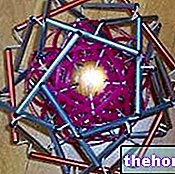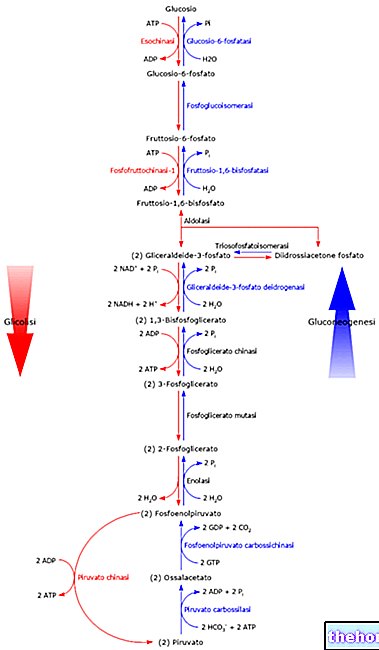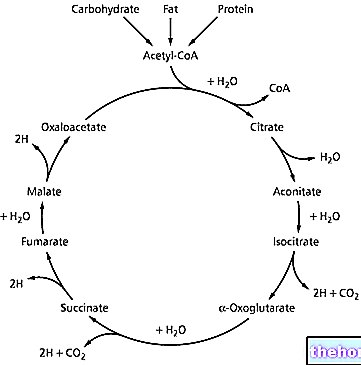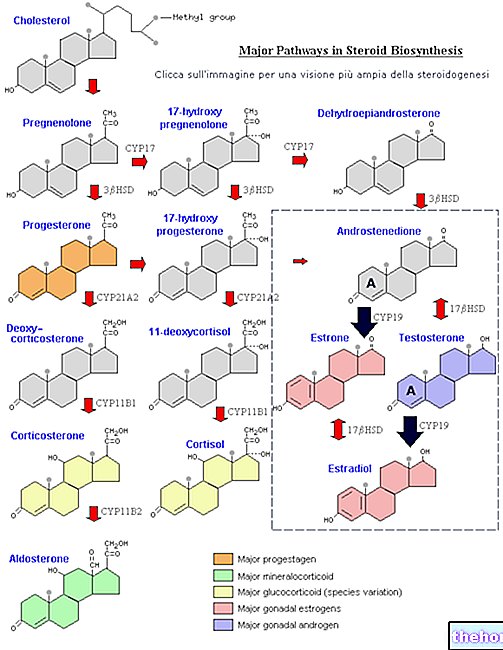In order to be able to speak in an understandable way of the "hemoglobin (Hb), it is useful to take care of the first myoglobin (Mb) which is very similar to hemoglobin but is much simpler. Between hemoglobin and myoglobin there are strict kinship relationships: both are conjugated proteins and their prosthetic group (non-protein part) is the group heme.
Myoglobin is a globular protein consisting of a single chain of about one hundred and fifty amino acids (it depends on the organism) and its molecular weight is about 18 Kd.
As mentioned, it has a heme group which is inserted in a hydrophobic (or lipophilic) portion of the protein, consisting of folds attributable to the α-helix structures of the fibrous proteins.
Myoglobin is mainly composed of segments of α-helices, present in number of eight and consists, almost exclusively, of non-polar residues (leucine, valine, methionine and phenylalanine) while polar residues are practically absent (aspartic acid, glutamic acid, lysine and arginine); the only polar residues are two histidines, which play a fundamental role in the attachment of oxygen to the heme group.
The heme group is a chromophore group (absorbs in the visible) and is the functional group of myoglobin.
See also: glycated hemoglobin - hemoglobin in the urine
A little bit of chemistry

The bond between protoporphyrin and iron is a typical bond of coordination compounds which are chemical compounds in which a central atom (or ion) forms bonds with other chemical species in a number greater than its oxidation number (electric charge). In the case of heme, these bonds are reversible and weak.
The coordination number (number of coordination bonds) of iron is six: there may be six molecules around the iron sharing the bonding electrons.
To form a coordination compound, it takes two orbitals with correct orientation: one able to "acquire" electrons and the other able to donate them.
In heme, iron forms four planar bonds with the four nitrogen atoms at the center of the proto-porphyrin ring and a fifth bond with a proximal histidine nitrogen; iron has the sixth free coordination bond and it can bind to oxygen.
When iron is in the form of a free ion, its type orbitals d they all have the same energy; in myoglobin, the iron ion is bound to protoporphyrin and histidine: these species magnetically perturb the orbitals d some iron; the extent of the perturbation will be different for the various orbitals d depending on their spatial orientation and that of the perturbing species. Since the total energy of the orbitals must be constant, the perturbation causes an energetic separation between the various orbitals: the energy acquired by some orbitals is equivalent to the energy lost by the others.
If the separation that occurs between the orbitals is not very large, a high spin electronic arrangement is preferable: the binding electrons try to arrange themselves in parallel spins in as many sub-levels as possible (maximum multiplicity); if, on the other hand, the perturbation is very strong and there is a large separation between the orbitals, it may be more convenient to pair the bond electrons in the lower energy orbitals (low spin).
When iron binds to oxygen, the molecule assumes a low spin arrangement while when iron has the sixth coordination bond free, the molecule has a high spin arrangement.
Thanks to this spin difference, through a spectral analysis of myoglobin, we are able to understand if oxygen (MbO2) is bound to it or not (Mb).
Myoglobin is a typical muscle protein (but it is not found only in muscles).
Myoglobin is extracted from the sperm whale in which it is present in large quantities and is then purified.
Cetaceans have a respiration like that of human beings: having lungs they must absorb air through the respiratory process; the sperm whale must carry as much oxygen as possible in the muscles that are able to accumulate oxygen by binding it to the myoglobin present in them; the oxygen is then released slowly when the cetacean is immersed because its metabolism requires oxygen: the greater the amount of oxygen that the sperm whale is able to absorb and the more oxygen is available during the dive.
Myoglybin binds oxygen in a reversible manner and is present in peripheral tissues in a greater percentage the more that tissue is used to working with oxygen supplies that are distant in time.
<--- Myoglobin is a protein present in the muscles, whose function is precisely that of an oxygen "reservoir".
What makes the meat more or less red is the content of haemoproteins (it is the heme that makes the meat red).
Hemoglobin has many structural similarities to myoglobin and is able to bind molecular oxygen in a reversible way; but, while myoglobin is confined in the muscles and peripheral tissues in general, the hemoglobin is found in the erythrocytes or red blood cells (they are pseudo cells that is not real cells) which make up 40% of the blood.
Contrary to myoglobin, the work of hemoglobin is to take oxygen in the lungs, release it into the cells where it is needed, take carbon dioxide and release it into the lungs where the cycle begins again.
L"hemoglobin it is a tetrameter, that is, it is made up of four polypeptide chains each with a heme group and identical two by two (in a human being there are two alpha chains and two beta chains).
The main function of hemoglobin is the transport of oxygen; another function of the blood in which hemoglobin is involved is the transport of substances to the tissues.
On the way from the lungs (rich in oxygen) to the tissues, hemoglobin transports oxygen (at the same time the other substances reach the tissues) while in the reverse path, it carries with it the waste collected by the tissues, especially the carbon dioxide produced in the metabolism.
In the development of a human being there are genes that are expressed only for a certain period of time; for this reason there are different hemoglobins: fetal, embryonic, of the adult man.
The chains that make up these different hemoglobins have different structures but with some similarities in fact the function they perform is more or less the same.
An explanation of the presence of several different chains is the following: in the course of the evolutionary process of organisms, even hemoglobin has evolved specializing in the transport of oxygen from areas that are rich in it to areas that are deficient. At the "beginning of the evolutionary chain l" hemoglobin transported oxygen in small organisms; in the course of evolution the organisms reached larger dimensions, therefore the hemoglobin was modified to be able to transport oxygen to areas further away from the point where it was rich in it; to do this they have been coded, in the course of the evolutionary process, new structures of the chains that make up hemoglobin.
Myoglobin binds oxygen even at modest pressures; in the peripheral tissues there is a pressure (PO2) of about 30 mmHg: myoglobin at this pressure does not release oxygen, so it would be ineffective as an oxygen carrier. The hemoglobin, on the other hand, it has a more elastic behavior: it binds oxygen to high pressures and releases it when the pressure decreases.
When a protein is functionally active, it can change its shape somewhat; for example, oxygenated myoglobin has a different shape from non-oxygenated myoglobin and this mutation does not affect its neighbors.
The situation is different in the case of associated proteins such as hemoglobin: when a chain oxygenates it is induced to change its shape but this modification is three-dimensional so the other chains of the tetrameter are also affected. The fact that the chains are associated with each other. , suggests that the modification of one affects the other neighbors even if to a different extent; when a chain oxygenates, the other chains of the tetrameter assume a "less hostile attitude" towards oxygen: the difficulty with which a chain it oxygenates decreases as the chains close to it oxygenate in turn. The same goes for deoxygenation.
The quaternary structure of deoxyhemoglobin is called the T (tense) form while that of oxyhemoglobin is called the R (released) form; in the tense state there are a series of rather strong electrostatic interactions between acidic amino acids and basic amino acids that lead to a rigid structure of deoxyhemoglobin (this is why the "tense form"), while when oxygen is linked, the entity of these interactions decreases (hence the "released form"). Furthermore, in the absence of oxygen, the charge of the histidine (see structure) is stabilized by the opposite charge of the aspartic acid while, in the presence of oxygen, there is a tendency on the part of the protein to lose a proton; all this involves that oxygenated hemoglobin is a stronger acid than deoxygenated hemoglobin: bohr effect.
Depending on the pH, the heme group binds more or less easily to oxygen: in an acidic environment, hemoglobin releases oxygen more easily (the tense form is stable) while, in a basic environment, the bond with oxygen is harder.

Each hemoglobin releases 0.7 protons per mole of oxygen (O2) entering.
The Bohr effect allows hemoglobin to improve its ability to carry oxygen.
The hemoglobin that travels from the lungs to the tissues must balance itself as a function of pressure, pH and temperature.
Let's see the effect of temperature.
The temperature in the pulmonary alveoli is about 1-1.5 ° C lower than the external temperature while, in the muscles the temperature is about 36.5-37 ° C; as the temperature increases, the saturation factor drops (at the same pressure): this happens because the kinetic energy increases and dissociation is favored.

There are other factors that can affect the ability of hemoglobin to bind to oxygen, one of which is the concentration of 2,3 bisphosphoglycerate.
2,3 bisphosphoglycerate is a metabolic present in erythrocytes in a concentration of 4-5 mM (in no other part of the organism is it present in such a high concentration).
At physiological pH, 2,3 bisphosphoglycerate is deprotonated and has five negative charges on it; it is wedged between the two beta chains of hemoglobin because these chains have a high concentration of positive charges. The electrostatic interactions between the beta chains and the 2,3 bisphosphoglycerate confer a certain rigidity to the system: a tense structure is obtained which has little affinity for oxygen; during oxygenation, the 2,3 bisphosphoglycerate is then expelled.
In erythrocytes c "is a special apparatus that converts 1,3 bisphosphoglycerate (produced by metabolism) into 2,3 bisphosphoglycerate so that it reaches a concentration of 4-5 mM and therefore the hemoglobin is able to exchange the "oxygen in the tissues.
The hemoglobin arriving at a tissue is in the released state (bound to oxygen), but in the vicinity of the tissue, it is carboxylated and passes to the tense state: the protein in this state has less tendency to bind with oxygen, with respect to the released state, therefore hemoglobin releases oxygen to the tissue; moreover, by reaction between water and carbon dioxide, there is the production of H + ions, therefore further oxygen due to the bohr effect.
Carbon dioxide diffuses into the erythrocyte passing through the plasma membrane; since erythrocytes make up about 40% of the blood, we should expect that only 40% of the carbon dioxide that diffuses from the tissues enters them, in reality 90% of the carbon dioxide enters the erythrocytes because they contain an enzyme that converts carbon dioxide in carbonic acid, it results that the stationary concentration of carbon dioxide in the erythrocytes is low and therefore the speed of entry is high.

Another phenomenon that occurs when an erythrocyte reaches a tissue is the following: by gradient, the "HCO3- (derivative of carbon dioxide) leaves the" erythrocyte and, to balance the output of a negative charge, we have the " entry of chlorides which determines an increase in osmotic pressure: to balance this variation there is also the entry of water which causes swelling of the erythrocyte (HAMBURGER effect). The opposite phenomenon occurs when an erythrocyte reaches the pulmonary alveoli: deflation of the erythrocytes (HALDANE effect) Therefore the venous erythrocytes (directed to the lungs) are rounder than the arterial ones.

















.jpg)











